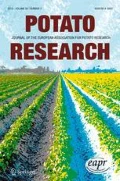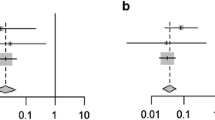Summary
Organo-mercury compounds are used on a commercial scale in Scotland for disinfecting potato tubers to control various tuber diseases and tuber-borne pathogens such asRhizoctonia solani, but the compounds are very poisonous to mammals and could present a hazard under certain conditions. Certain organo-tin compounds, some of which show promise as active fungicides, are much less toxic, and a number of these were screened for their killing action on sclerotia ofR. solani.
Good results were obtained with two substances, one of which (diethyloctyltin oxide) was difficult to synthesize chemically and was therefore too expensive for commercial use. The other (tributyltin acetate) being cheaper and readily available, was compared with an organo-mercury disinfectant (methoxyethylmercury chloride) on a field scale. Both chemicals adequately controlled dry rot (Fusarium caeruleum) and gangrene (Phoma foveata), but the tin compound had a powerful phytotoxic action on the tubers which resulted in considerable loss of treated tubers in store and caused marked reductions in emergence and yield when tubers which survived the treatment were grown on.
It is concluded that, at present, organo-tin compounds are unlikely to supercede organo-mercury compounds for disinfecting potato tubers immediately after lifting in Scotland.
Zusammenfassung
In Schottland werden organische Quecksilber-Verbindungen in handelsüblichem Rahmen zur Desinfektion von Kartoffelknollen angewendet, um verschiedene Knollenkrankheiten und knollengebundene Krankheitserreger, wieRhizoctonia solani, zu bekämpfen. Diese Verbindungen sind aber für Säugetiere giftig und könnten unter gewissen Umständen eine Gefahr bedeuten. Die Suche nach weniger giftigen Substanzen ist deshalb weitergeführt worden. Gewisse organische Zinn-Verbindungen, die viel weniger giftig als die quecksilberhaltigen Mittel, aber offenbar wirksame Schädlingsbekämpfungsmittel sind, wurden einer Prüfung unterzogen.
Die Wasserlöslichkeit der organischen Zinn-Verbindungen wurde zuerst bestimmt, da bekannt ist, dass dieser Eigenschaft große Bedeutung in der Wirksamkeit gegenR. solani zukommt, siehe Ergebnisse intabelle 1. Die Verbindungen wurden dann auf gleiche Weise, wie dies für organische Quecksilber-Verbindungen gilt (Graham, 1960), auf die abtötende oder hemmende Wirkung gegenüber Sklerotien vonR. solani durchgetestet, indem Lösungen oder Suspensionen angewendet wurden, die 100 p.p.m. Zinn plus ein Netzmittel enthielten. Die Ergebnisse sind intabelle 2 zusammengestellt. Sie zeigen, daß zwei Verbindungen, nämlich Tributyl-Zinn-Azetat (TBTA), und Diäthyloctyl-Zinn-Oxid (DEOTO), sehr wirksam sind gegen Sklerotien, doch wurde DEOTO nicht weiter geprüft, da es sehr schwierig war, diese Verbindung chemisch herzustellen und sie deshalb im Handel wahrscheinlich zu teuer wäre.
Ein Problem bei den organischen Zinn-Verbindungen ist ihre Phytotoxizität. Um diese beurteilen zu können, wurde ein kleiner Ertragsversuch durchgeführt, dessen Ergebnisse intabelle 3 angegeben sind. Auf Grund der obenerwähnten Versuchsergebnisse wurde TBTA ausgewählt und im Vergleich zu einem organischen Quecksilber-Desinfektionsmittel (Methoxyäthyl-Quecksilberchlorid, MEMC) in einem Feldversuch angewendet, um vor allem die Phytotoxizität, besonders nach mechanischem Waschen, festzustellen. Für diesen Versuch wurden Knollen der SorteMajestic 28 Tage nach dem Abbrennen der Stauden mit schwefliger Säure geerntet und innerhalb 48 Stunden nach der Ernte mit folgenden fünf Verfahren behandelt:
-
A.
Nur in Kisten aufbewahrt.
-
B.
Gewaschen in einer Kartoffelwaschmaschine mit 4,9 kg/cm2 (70 lb/in2) Wasserdruck, dann in Kisten eingefüllt.
-
C.
Gewaschen wie unter B, 12 Minuten eingetaucht in MEMC-Lösung, enthaltend 100 p.p.m. Quecksilber — Netzmittel, dann in Kisten eingefüllt.
-
D.
Gewaschen wie unter B, 12 Minuten eingetaucht in MEMC-Lösung, enthaltend 50 p.p.m. Quecksilber — Netzmittel, dann in Kisten eingefüllt.
-
E.
Gewaschen wie unter B, 12 Minuten eingetaucht in TBTA-Lösung, enthaltend 100 p.p.m. Zinn — Netzmittel, dann in Kisten eingefüllt.
Nach der Behandlung wurden die Knollen getrocknet und bis zur Pflanzzeit in Kisten gelagert. Beide Präparate bekämpften die Trockenfäule (Fusarium caeruleum) und Phoma-Knollenfäule (Phoma foveata) ausreichend, doch verursachte TBTA beträchtliche Schäden an den Knollen (tabelle 4). Die überlebenden Knollen wurden in einem 5 — 5 Lateinischen Quadrat im Feld ausgepflanzt und hernach Auflaufen und Ertrag bestimmt (tabelle 5). Die Ergebnisse zeigen, daß TBTA — verglichen mit MEMC — eine merkliche Verschlechterung im Auflaufen und im Ertrag verursachte. Daraus wird geschlossen, daß gegenwärtig organische Zinn-Verbindungen wahrscheinlich kaum die organischen Quecksilber-Verbindungen als Desinfektionsmittel für Kartoffelknollen übertreffen, wenn Knollen unmittelbar nach der Ernte damit behandelt werden, wie es in Schottland in der Praxis üblich ist.
Résumé
Les composés organo-mercuriques sont utilisés sur une échelle commerciale en Ecosse pour maitriser diverses maladies et agents pathogènes du tubercule, tel queRhizoctonia solani; toutefois ces composés sont toxiques pour les mammifères et peuvent présenter un danger sous certaines conditions. Une recherche de substances moins toxiques a été poursuivie et certains composés organiques d'étain ont été examinés, qui sont beaucoup moins toxiques que les mercuriques tout en étant apparemment des fongicides actifs. En premier lieu la solubilité dans l'eau des composés organiques d'étain a été déterminée parce qu'il est connu que c'est là un important facteur d'activité contreR. solani; les résultats sont donnés dans letableau 1. Les composés sont alors classés suivant leur action fongicide ou inhibitrice sur les sclérotes deR. solani, suivant la manière décrite parGraham (1960) pour les composés organo-mercuriques, c'est-à-dire en utilisant des solutions ou suspensions contenant 100 parties par million (p.p.m.) d'étain plus un agent mouillant. Les résultats sont résumés dans letableau 2. Ils montrent que deux composés, à savoir le tributylacétate d'étain (TBTA) et le diéthyloctyloxide d'étain (DEOTO), sont très actifs contre les sclérotes; toutefois les recherches avec DEOTO, dont la synthèse chimique est difficile et qui, par conséquent, aurait probablement été trop onéreux pour une utilisation commerciale, n'ont pas été poursuivies.
Se pose le problème de la phytotoxicité des composés organiques d'étain; pour établir celle-ci, un petit essai de production fut fait dont les résultats figurent autableau 3. Sur la base des résultats obtenus. TBTA fut retenu pour être comparé avec un désinfectant organo-mercurique (le méthoxyéthyl chlorure de mercure, MEMC), dans une nouvelle et vaste expérience sur champ, afin de déterminer la phytotoxicité, particulièrement après lavage mécanique. Dans cette expérience les tubercules de la variétéMajestic sont récoltés 28 jours après brûlage complet des fanes à l'acide sulfurique et subissent les cinq traitements suivants 48 heures après arrachage:
-
A.
mis en caisses sans autre traitement;
-
B.
lavés dans une machine à laver les pommes de terre à 4,9 kg/cm2 (70 lb/in2) de pression d'eau, puis mis en caisses;
-
C.
lavés comme en B., trempés 12 minutes dans une solution de MEMC contenant 100 p.p.m. de mercure plus le mouillant, puis mis en caisses;
-
D.
lavés comme en B., trempés 12 minutes dans une solution de MEMC contenant 50 p.p.m. de mercure plus le mouillant, puis mis en caisses;
-
E.
lavés comme en B., trempés 12 minutes dans une solution TBTA contenant 100 p.p.m. d'étain plus le mouillant, puis emmagasinés.
Après traitement, les tubercules sont séchés puis conservés en caisses jusqu'an moment de la plantation.
Les deux produits chimiques maitrisent suffisamment la pourriture sèche (Fusarium caeruleum) et la gangrène (Phoma foveata), mais TBTA cause des dommages chimiques considérables aux tubercules (tableau 4). Les tubercules restants sont plantés au champ en parcelles disposées en carré latin; on détermine la levée et le rendement (tableau 5). Les résultats révèlent que TBTA provoque des réductions nettes de levée et de production comparativement à MEMC; l'on conclut que, pour le moment, les composés organiques d'étain sont inefficaces pour remplacer les composés organo-mercuriques comme désinfectants des tubercules de pomme de terre quand on les utilise dans le traitement immédiatement après arrachage, ce qui constitue la pratique habituelle en Ecosse.
Similar content being viewed by others
References
Anon (1958): Stalinon: a therapeutic disaster.Brit. med. J. 1, 515.
Barnes, J. M., andH. B. Stoner (1958): Toxic properties of some dialkyl and trialkyltin salts.Brit. J. industr. Med. 15, 15–21.
Boyd, A. E. W. (1960): Fungicidal dipping and other treatments of seed potatoes in Scotland.Europ. Potato J. 3, 137–154.
Graham, D. C. (1960): Control ofRhizoctonia solani on potato by disinfection of seed tubers with organo-mercury compounds.Europ. Potato J. 3, 80–89.
—S. N. S. Srivastava andC. E. Foister (1957): The control ofRhizoctonia solani on potato.Plant Path. 6, 149–152.
Hartel, K. (1958): Organic tin compound as a crop fungicide. Tin and its uses.Quarterly Journal of the Tin Research Institute. No. 43, 9–14.
— (1962): Triphenyltin compounds. A new fungicidal group of active substances — their biological properties and their application to agriculture.Agric. and Vet. Chemicals. 3, 19–24.
Holmes, T. D., andI. F. Storey (1962): Comparative trials of copper, dithiocarbamate and organotin fungicides for blight control in Lincolnshire 1958–1961.Plant Path. 11, 139–146.
Kerk, G. J. M. van der, andJ. G. A. Luijten (1954): Investigations on organo-tin compounds. 3. The biocidal properties of organo-tin compounds.J. appl. Chem. 4, 314–319.
Lint, M. M. de, andJ. H. van Emden (1957): Control of Black Scurf and Stem Canker (Rhizoctonia solani Kuhn) by disinfection of seed potatoes.Prov. IVth International Congress of Crop Protection Hamburg, 1957,2, 1443–1444.
Lyle, W. H. (1958): Lesions of the skin in process workers caused by contact with butyltin compounds.Brit. J. industr. Med.,15, 193–196.
Pieters, A. J. (1961): Triphenyltin hydroxide, a fungicide for the control ofPhytophthora infestans on potatoes and some other fungus diseases.Proc. British Insecticide and Fungicide Conference 2, 461–470.
Author information
Authors and Affiliations
Rights and permissions
About this article
Cite this article
Graham, D.C. The use of organo-tin compounds as potato tuber disinfectants, particularly againstRhizoctonia solani . Europ. Potato J. 7, 33–44 (1964). https://doi.org/10.1007/BF02366305
Received:
Issue Date:
DOI: https://doi.org/10.1007/BF02366305




